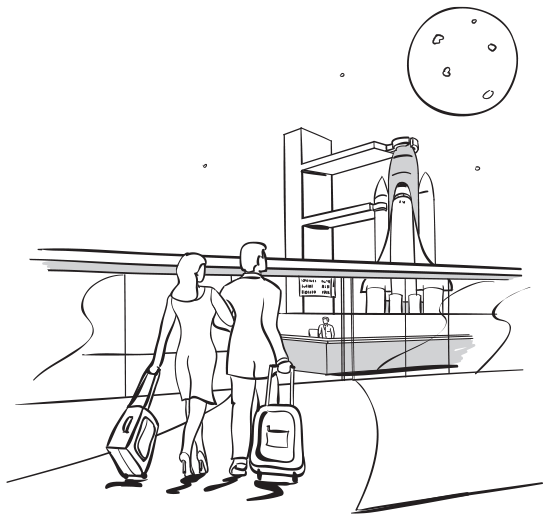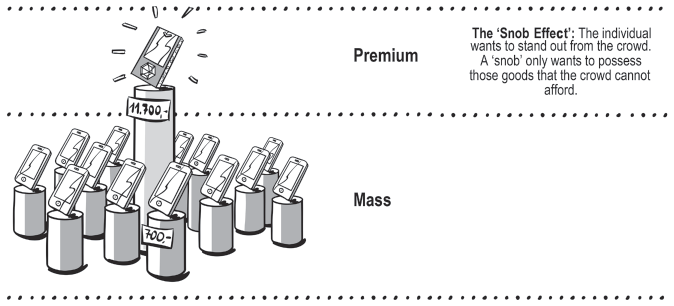Ultimate Luxury
More for more

The pattern
The Ultimate Luxury pattern focuses on customers in the very top financial bracket (WHO?). Companies that operate here can distinguish their products or services by providing the highest-quality privileges and services, commensurate with the spending power of the wealthy market it targets: uniqueness and self-actualisation are values that appeal to these buyers (VALUE?). The great investments required to provide these products and services are offset by the wide margins practised. Thus, the focus lies on branding, employment of competent and knowledgeable sales representatives to promote goods and services and frequent memorable special events for customers (HOW?, WHAT?). The market for luxury goods is growing globally, especially in China and Russia. Microeconomics talks about the ‘snob effect’: luxury watches sell better at higher prices. To reach the extremely affluent, thorough adjustment of the business model is necessary.

The origins
Ultimate Luxury actually dates back to antiquity. Merchants presented ancient Roman patricians with precious fabrics for clothes and gems for intricate jewellery, and architects designed pompous and spacious palaces and villas to house luxurious furniture. All this served to give the upper classes an air of respectability and gave them a sense of self-realisation. During the Middle Ages, many businesses sought to become official purveyors to the court, which afforded them the privilege of displaying the royal coat of arms on their goods and services. The super-rich are the modern version of royalty – while they might not have a kingdom, they do have similar needs and desires.
The innovators
A number of companies have made use of the Ultimate Luxury business model. Among these is Lamborghini, which was founded in 1963 by Ferruccio Lamborghini. His company’s small-scale or limited-edition approach to the manufacture and sale of high-powered sports cars makes for high prices. Its wealthy clientele is happy to respond, encouraged by the company’s policy of close customer contact and comprehensive support packages. Thanks to this strategy, Lamborghini is able to realise high margins to finance development, production and marketing. Customer orders are driven by the exclusive nature, performance and image of the products, with resultant high revenue and profits for Lamborghini. The company’s crest prominently displays Murciélago, a bull that survived a bullfight in 1879 (even though it was pierced by 24 lances) and was later pardoned for this astonishing feat. The crest therefore symbolises strength. When the company was first established, it differentiated itself from its competitors through the superior power of its motors. In the second year of its existence, Lamborghini surprised car enthusiasts everywhere when it introduced the 12-cylinder 350 GT that outshone all of Ferrari’s cars at the time. In 1966, Lamborghini introduced the Miura, which with its 350 horsepower engine could reach speeds of almost 300 km/h. All Lamborghini car models are named after famous Spanish bull breeds (Diablo, Gallardo, Murciélago), except for the Countach – a Piedmontese exclamation meaning ‘best of the best’.
Jumeirah Group develops Ultimate Luxury hotels. The company’s portfolio includes the Jumeirah Beach Hotel, Emirates Towers, as well as what is probably the most famous and luxurious hotel in the world – the Burj al Arab in Dubai. The hotel’s impressive height of 321 metres and its inimitable sail shape are a magnet for the wealthiest. Officially awarded five stars, it is considered the most luxurious hotel in the world, far exceeding the requirements for a five-star hotel (some rate it as the world’s only seven-star hotel). Its ostentatiously spacious and luxuriously furnished suites are between 169 and 780 square metres in size. Guests wishing to take a break from the lavish interiors can use the hotel’s helicopter or one of several Rolls-Royce cars offered by the hotel to make a foray into the city. These high standards of service are costly to maintain, but are offset by high margins.
Founded in 2002 by multi-entrepreneur Elon Musk, SpaceX’s vision is to revolutionise space travel and to ultimately enable people to live on other planets. As the first successful private company to break the government research institutes’ monopoly on space exploration, SpaceX overcame the dominant industry logic by aiming to commercialise space travelling. Conceptualised over a long time period, this ambitious goal shows remarkable interim successes: SpaceX achieved the historic first re-flight of an orbital class rocket in 2017, besides regularly launching flight-proven rockets. Still in the process of working to provide space travel to Mars for estimated costs of between US $100,000 and 500,000 in 2019, the Ultimate Luxury pattern applies from another angle. In order to bring space exploration to private customers, costs for space flights must come down, which SpaceX achieves by optimising overheads, support activities, technology development and the reuse of space shuttles by making them also a supplier for governmental space programmes.
When and how to apply Ultimate Luxury
You may be tempted to increase your prices, but bear in mind that the market for luxury goods is a very small one. However, there is substantial potential in emerging markets, where you can cater to new millionaires and billionaires with an eye for luxury.
Some questions to ask
- Can we create value for people who already have everything?
- How do we handle fluctuating demand, given the low number of consumers we will be serving?
- What kinds of employees will we need in order to deliver on our clients’ extremely high expectations?

